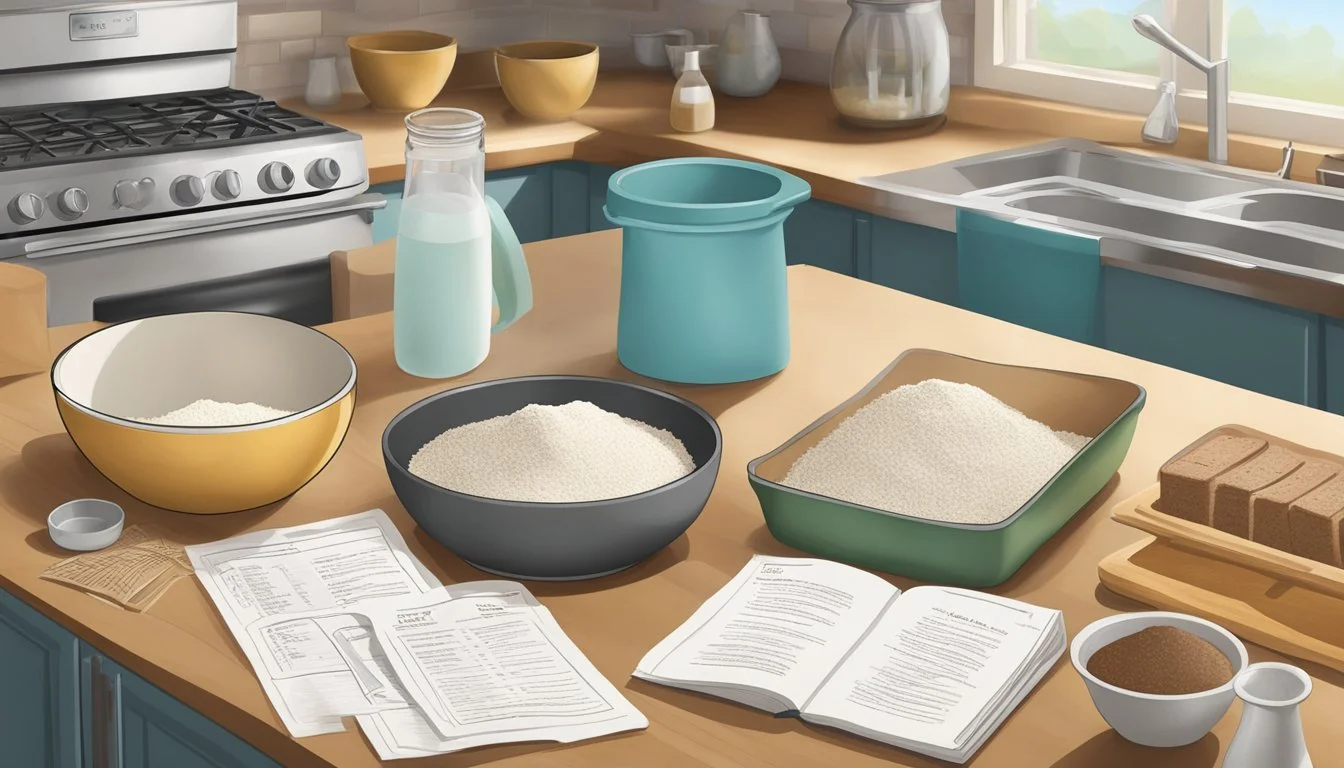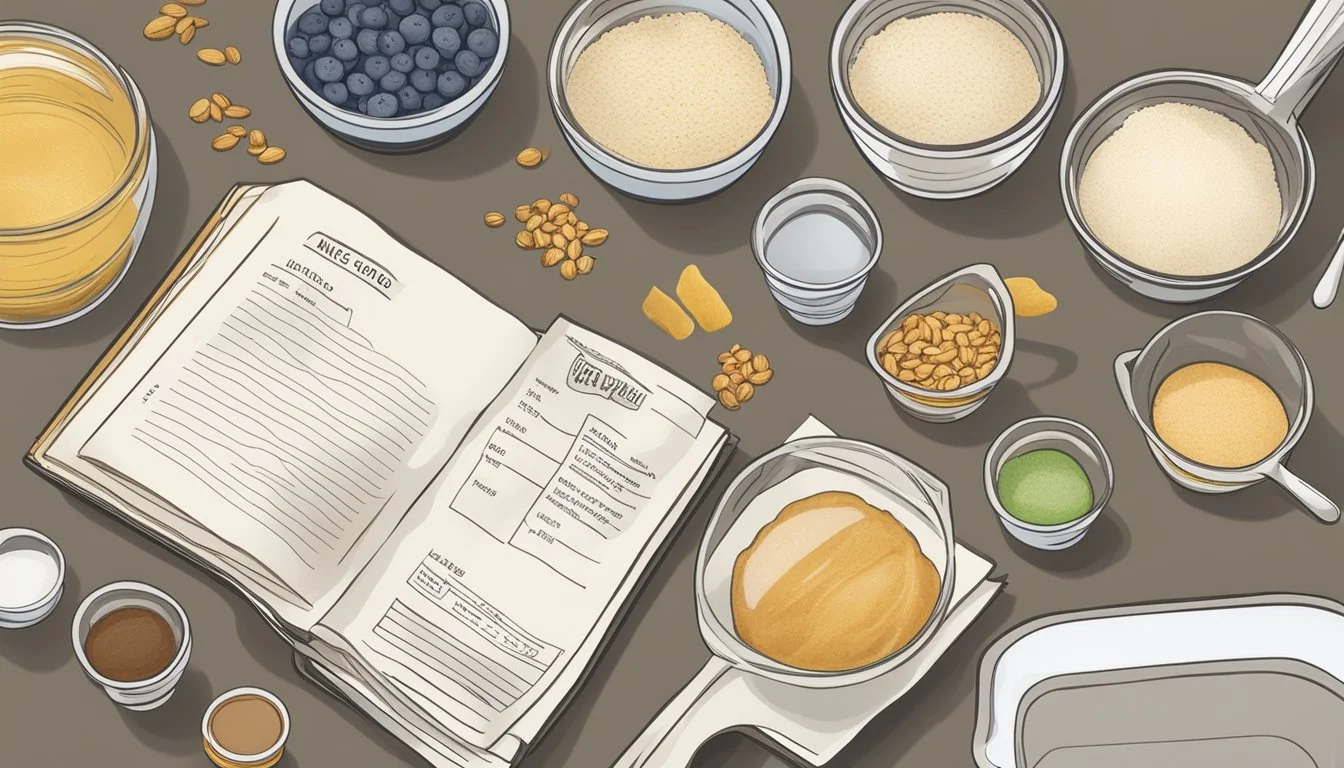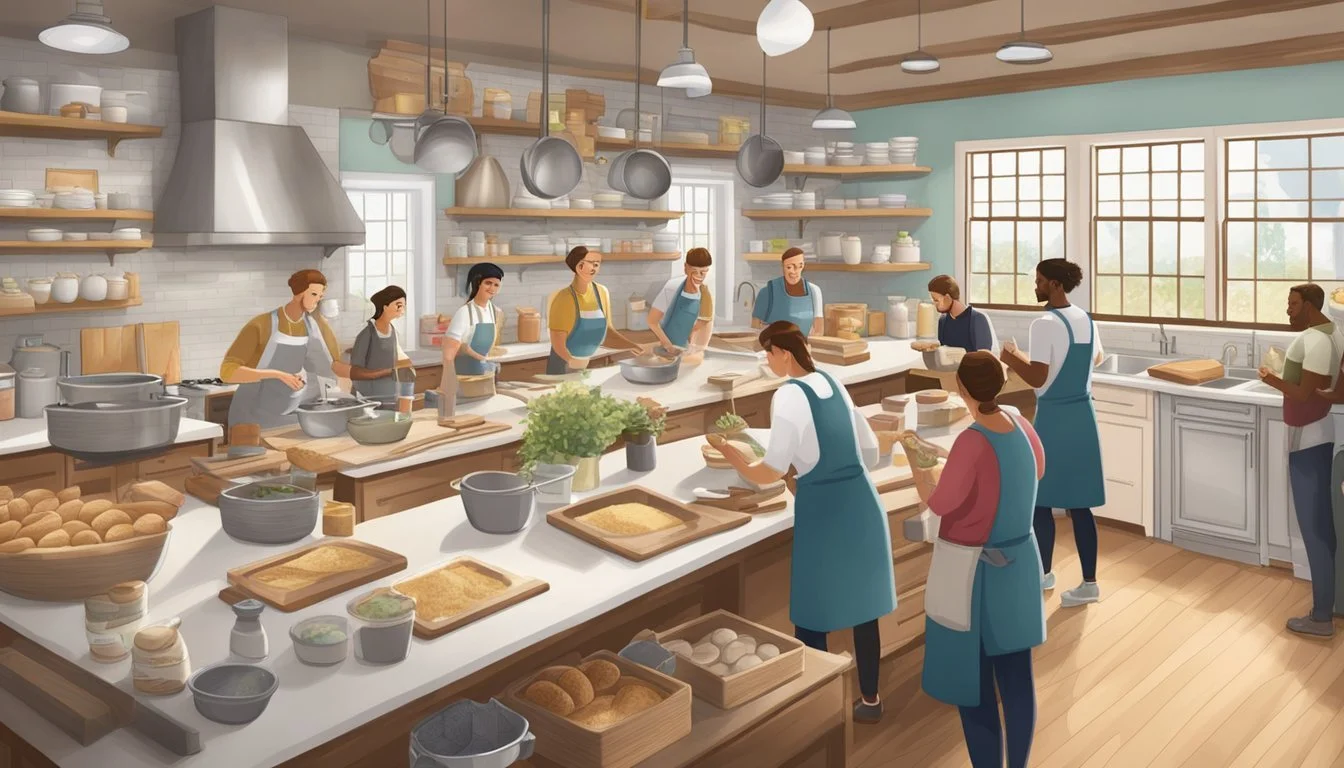How to Cook with King Arthur Flour
Expert Tips for Baking Success
Baking with King Arthur Flour is a choice many bakers, from novices to professionals, make to ensure their creations turn out consistently great. This beloved flour company has been providing high-quality products for over two centuries, with a commitment to standards that make their flours stand out in the pantry. Its all-purpose flour, for example, is renowned for its reliability and versatility in a variety of recipes, from fluffy cakes to chewy cookies. By understanding the properties of King Arthur Flour, one can master the art of baking and elevate their baked goods to a new level.
Precision in measuring ingredients is a cornerstone of baking success, and with King Arthur Flour, consistency is key. As their baking guides suggest, the weight of flour can dramatically affect the outcome of a recipe. Measuring flour by weight ensures accuracy, and for King Arthur Flour, 120 grams is the standard weight for one cup of their all-purpose flour. They articulate that while the method of scooping flour can vary the amount you get, weighing it ensures the same result every time, leading to the consistent, delectable outcomes bakers seek.
Beyond just the right measurements, King Arthur provides an array of recipes designed to showcase the flour's potential. With an expansive collection that includes everything from classic waffles to intricate Bundt cakes, they cater to every baking occasion. Their recipes are not just about creating beautiful and tasty desserts, but also about understanding the science of baking, which helps bakers develop skills that can be applied across all their culinary endeavors. Using King Arthur Flour as a foundation, one can explore a world of flavors and textures, impressing guests and satisfying cravings with each oven timer's ring.
The Essentials of Baking with King Arthur Flour
King Arthur Flour is renowned for its consistency and quality, providing a stable foundation for all baking endeavours. When using their flour, bakers should focus on precise measurements, which is crucial for baking success. One must adhere to using 120 grams per cup of all-purpose flour to maintain accuracy, as King Arthur Flour dictates for its all-purpose flour.
Measurement Precision:
Scoop & Level: Gently scoop flour into the measuring cup, then level with a knife.
Weighing: For best results, use a digital scale to measure 120g per cup.
Understanding Ingredients:
Protein Content: King Arthur Flour typically has a higher protein content, around 11.7%, which directly affects gluten formation.
Gluten Formation: The right protein level is pivotal for the structure and rise of baked goods.
Selecting the Right Flour:
All-Purpose: Versatile for a wide range of baked goods.
Bread (What wine goes well with bread?) Flour: Ideal for yeast bread with its higher protein content.
Whole Wheat: Rich in nutrients, providing a different flavor and texture.
Utilizing Wheat Varieties:
Soft Wheat: Lower in protein, perfect for cakes and pastries.
Hard Wheat: Higher in protein, suited for bread and chewy baked items.
Bakers appreciate the reliability of King Arthur Flour, knowing its dependable protein content and quality will yield excellent gluten development and consistent results across various baking applications. It's essential to select the proper type of flour to match the desired outcome, whether it's creating a tender cake or a hearty loaf of bread. By mastering these foundational elements, bakers can feel confident in their baking pursuits with King Arthur Flour.
Choosing the Right King Arthur Flour
When baking, the choice of flour can greatly influence the texture and structure of the finished product. King Arthur Flour offers a range of specialized flours to cater to different recipes and desired outcomes.
Understanding Flour Types
King Arthur Baking produces a variety of flours, each designed for specific baking needs. Their lineup includes all-purpose flour, which is versatile and commonly used for a wide range of recipes. For a tender crumb in cakes and pastries, cake flour with a lower protein content is ideal. Bakers often reserve bread flour for yeast-leavened products due to its higher protein content, which helps in forming a strong gluten network for the dough.
Protein Content and Baking Outcomes
Protein content in flour is directly correlated with gluten formation, which impacts the texture of baked goods. King Arthur Flour generally has a higher protein content compared to many other brands, ranging from 11.7% to 12.7% in their all-purpose flour. This results in:
Bread flour: Stronger gluten networks, which is perfect for chewy bread textures.
Cake flour: Reduced protein for delicate and soft textures, suitable for cakes and fine pastries.
All-purpose flour: A balanced option that accommodates both structural integrity and tenderness, useful for an array of recipes.
By knowing the protein content and flour type, bakers can predict and influence the texture and structural outcome of their baked creations with King Arthur Flour.
Mastering Baking Techniques
One begins a baking journey with the understanding that technique is the backbone of success. Properly kneading dough enhances the development of gluten, which imparts both extensibility and elasticity, key properties in achieving the desired rise and texture in bread.
Consistency in Measuring Ingredients:
Flour: Use a scale to measure 120g for a cup of King Arthur's all-purpose flour.
Leavening agents: Measure level teaspoons to ensure a proper rise.
Kneading:
Combine ingredients with confidence until the dough is smooth.
Knead by hand or with a mixer until the dough is elastic and passes the "windowpane test."
Shaping and Preparing Dough:
Shape dough into its final form gently yet firmly.
Allow dough to rise in a draft-free environment until doubled in size.
Baking:
Preheat the oven to the correct temperature before baking.
Use a nonstick mat or parchment paper to prevent sticking and achieve an even crust.
Useful Tips:
A cookie scoop helps achieve uniformly shaped cookies.
Slash the top of bread loaves to control expansion in the oven.
The baker employs these precise techniques, forming each loaf with care, leading to picturesque creations every time they wield their spatula or dough scraper. Remember, mastery comes with practice, and each batch is a step closer to baking perfection.
Bread Baking with King Arthur
When baking bread with King Arthur Flour, one can achieve exceptional texture and flavor. By choosing the correct flour and following tried-and-true methods, bakers of all levels can create everything from hearty yeast breads to tangy sourdoughs and quick breads with ease.
Yeast Breads
For yeast breads, King Arthur's Unbleached All-Purpose Flour or Bread Flour can be used to create a strong gluten network essential for the dough's elasticity and rise. The protein content of 11.7% in all-purpose and the slightly higher 12.7% in bread flour ensures consistency in results. The process involves mixing the ingredients together, kneading to develop gluten, and allowing time for the dough to rise. After shaping the loaves, they are baked until golden and sound hollow when tapped on the bottom, a clear indicator of doneness.
Ingredients:
Flour (King Arthur's)
Active dry or instant yeast
Water
Salt
Additional fats or sugars (optional)
Key Steps:
Mix to form a shaggy dough.
Knead to develop gluten.
Proof until doubled in size.
Shape and second proof.
Bake in a preheated oven.
Sourdough Breads
With sourdough breads, using King Arthur Flour brings robust flavor and a chewy texture to the bake. Beginning with a sourdough starter—flour and water fermented with naturally occurring yeast and bacteria—the baker combines it with more flour and water to form the dough. It's essential to ensure the starter is active and bubbly before mixing. Sourdough requires a longer fermentation period which can range from several hours to overnight, developing the bread's characteristic tang and improving the texture.
Sourdough Essentials:
Active sourdough starter
King Arthur Flour
Water
Salt
Fermentation Stages:
Mix with active starter.
Bulk ferment, with stretch and folds to strengthen dough.
Shape the dough.
Proof, preferably in a cool place.
Score and bake with steam.
Quick Breads
Quick breads are a delight for their simplicity and speed. King Arthur Flour provides the structure, lifting agents like baking powder or baking soda prompt a rapid rise, and ingredients like fruit, nuts, or dairy add flavor and moisture. Without the need for kneading or long fermentation periods, quick breads are mixed and then immediately poured into pans to bake. They can vary from sweet banana bread to savory cheese bread, satisfying different taste preferences.
Common Ingredients:
King Arthur Flour
Baking powder/soda
Eggs
Milk or buttermilk
Sugar
Flavor add-ins (e.g., fruits, nuts)
Baking Process:
Whisk the dry ingredients for even distribution.
Combine wet ingredients separately.
Fold together wet and dry ingredients.
Pour into a prepared pan and bake immediately.
Pastries and Pies
Crafting top-notch pastries and pies involves a delicate balance of technique and quality ingredients. King Arthur Flour provides an excellent base for both, ensuring the end product has the right texture and flavor.
Making Perfect Pastries
A key ingredient to achieving flaky, tender pastries is butter. Butter introduces flavor and creates steam when heated, which puffs up the layers of dough. It is crucial to keep the butter cold throughout the preparation process; this ensures that the fat is solid when it enters the oven, leading to better layer formation. Here's a simple breakdown:
Ingredients: Use high-quality, unsalted butter for control over the pastry's richness and salt content.
Technique: When cutting the butter into the flour, work quickly to prevent it from warming up and becoming greasy.
Temperature: Chill the dough before rolling it out to keep the butter firm, which is essential for creating well-defined layers.
Pies: Crust and Filling
For pies, the crust is just as important as the filling. A well-made crust is both sturdy and tender, capable of holding the filling without becoming soggy.
Combine King Arthur Flour with a pinch of salt.
Mix in cold butter and, optionally, a small amount of vegetable shortening for extra flakiness.
Gradually add ice water until the dough holds together without being wet or sticky.
Tip: The dough should be chilled before rolling out to relax the gluten and minimize shrinkage during baking.
Filling:
Balance the filling's moisture level; excessive moisture can result in an undercooked crust.
Precook certain fillings to concentrate flavors and reduce water content.
Pie Assembly: Ensure a strong seal between crust layers to prevent the filling from leaking out, causing a loss of flavor and potentially compromising the crust's texture.
By adhering to these guidelines and using King Arthur Flour, bakers can achieve pastries and pies with exceptional taste and structure.
Sweet Treats and Cookies
When baking with King Arthur Flour, one can achieve a remarkable array of sweet treats, from the most classic cookie recipes to innovative cakes with luscious frostings. The key to success lies in precise measurements, quality ingredients, and following techniques that enhance flavor and texture.
Cookies: From Classic to Creative
Baking cookies encompasses a range from time-honored classics to inventive new twists. For classic chocolate chip cookies, attention to detail makes all the difference. One must cream together sugars and butter until they reach a pale, fluffy consistency before adding vanilla and an egg. The flour should be King Arthur's, known for its reliable performance, blended just until incorporated, and then chocolate chips are folded in.
The dough is best scooped in two-tablespoon portions onto a baking sheet.
Bake at 375ºF until the edges are golden brown but the center remains soft.
For those seeking a super-soft chocolate chip cookie, using a tangzhong method, where a mixture of milk and flour is heated and then mixed into the dough to retain moisture, can create a softer texture. This added step helps the cookies stay moist longer, ensuring a tender bite.
Ingredients Function King Arthur Flour Provides structure Brown sugar Adds moisture and a caramel flavor Chocolate chips Melty pockets of chocolate Tangzhong (milk & flour mixture) Retains moisture for softness
Innovation in cookie recipes can also be seen through the addition of unexpected textures or flavors, such as browned butter for a nutty depth or a sprinkle of sea salt to balance sweetness.
Delectable Cakes and Frostings
Cakes crafted with King Arthur Flour can range from light and airy to dense and rich. For a cake as good as a bakery's, one must ensure that all ingredients are at room temperature before beginning. This ensures even mixing and better rise. Sugar, when beaten with butter or oil, helps to leaven the cake by incorporating air and gives it a tender crumb.
A cake's success is often in its rise and golden-brown exterior, indicators of proper baking.
The use of frostings can transform a simple cake into a decadent dessert.
The quality of flour used in the cake impacts its texture significantly, and King Arthur Flour is renowned for its consistent results. Whether opting for a velvety chocolate frosting or a zesty lemon buttercream, the contrast between a light, fluffy cake and a rich frosting creates a layered taste experience.
For a super-soft cake, similar to the super-soft cookies, a tangzhong can also be included. It adds moisture and can make each slice tender and plush. Baking at the correct temperature and checking for doneness with a toothpick are important steps to attain that much-desired golden-brown finish.
Savory Baking Adventures
King Arthur Flour excels in delivering reliable results for savory baking projects. Bakers can explore a spectrum of flavors and textures with their high-quality flour, ensuring that every crust and crumb is perfectly crafted for an enjoyable experience.
Homemade Pizza and Focaccia
One can create an unrivaled pizza crust with King Arthur Flour's blend of high-protein content, which contributes to the ideal chewy texture. For pizza dough, a simple combination of flour, water, yeast, and salt, with a bit of olive oil, can yield a flavorful, crispy crust that serves as the foundation for a variety of toppings.
Pizza Dough Ingredients:
King Arthur Flour
Water (warm)
Yeast (active dry or instant)
Salt
Olive oil
When tackling focaccia, the baker's goal is a light, airy interior with a crisp exterior. Hydration is key, and a higher water content in the dough can help achieve the characteristic holes and soft texture that make focaccia so delightful.
Focaccia Suggestions:
Generously oil the pan and dough surface.
Use a dimpling technique to create texture.
Add herbs and coarse salt for a savory flavor boost.
Savory Tarts and Quiches
For savory tarts and quiches, (What wine goes well with quiche?) a flaky, buttery crust is paramount. The pastry should be blind-baked to ensure it's fully cooked and can hold the savory filling without becoming soggy. King Arthur Flour aids in constructing a sturdy base that complements both the texture and the rich flavors of the filling.
Essential Steps for Tart Crust:
Mix flour with cold, cubed butter until a coarse, sandy texture is achieved.
Chill the dough before rolling out to maintain shape while baking.
Quiches require a silky smooth custard filling, balanced by the crust's crumbly texture. The flour's role is to fortify the crust, supporting the custard as it sets to a creamy consistency during baking.
Quiche Tips:
Whisk eggs and cream thoroughly for a uniform custard.
Sauté vegetables before adding them to the filling to enhance flavor.
By choosing King Arthur Flour for savory baking, the texture and flavor of pizzas, focaccias, tarts, and quiches are consistently impressive, catering to the sophisticated palate desiring home-baked, savory goodness.
Baking Tools and Equipment
When undertaking a baking project with King Arthur Flour, the baker's arsenal should be equipped with both basic and specialized tools. Quality and proper care of these tools ensure consistent baking success. Here's a must-have list for any baker:
Mixers: A sturdy stand mixer or a durable hand mixer is crucial for combining ingredients uniformly. They save time and effort, especially for doughs and batters.
Bowls: One should have a selection of mixing bowls in various sizes. Glass or metal bowls are preferred for their durability and ease of cleaning.
Baking Sheets: Heavy-duty baking sheets are essential for even heat distribution. Lining them with parchment paper or a silicone baking mat prevents sticking and allows for easy cleanup.
Oven: A reliable oven that maintains accurate temperatures is the centerpiece of baking. Regular oven calibration ensures precise heat settings.
To complete the baking process, one will need the following:
Plastic Wrap: Utilizing plastic wrap is effective for covering dough during resting or proofing to prevent it from drying out.
Rack: Cooling baked goods on a rack promotes air circulation to prevent sogginess.
Tool Use Mixer Combine ingredients efficiently Bowl Mix and prepare batters and doughs Baking Sheet Bake cookies, pastries, and more evenly Oven Essential for baking and achieving desired textures Plastic Wrap Keep dough moist during resting Rack Cool baked goods to avoid sogginess
The hand's role cannot be overstated. From kneading dough to shaping pastries, a baker’s hand technique is as important as any tool. Therefore, while the equipment aids the process, the skillful touch of a baker brings the creation to fruition.
Troubleshooting and Fixes
In baking, precision is key, and King Arthur Flour is a trusted partner in achieving baking success. This section equips the reader with targeted advice for correcting common baking missteps and making necessary adjustments due to environmental factors such as altitude and humidity.
Common Baking Missteps
Over or under-proofed dough: The dough's rise is a crucial part of baking. An under-proofed dough will result in a dense loaf, while over-proofing can cause the bread to collapse.
Fix: If the dough hasn't risen enough, allow more time in a warm, draft-free location. If over-proofed, reshape the dough by kneading lightly and allow it to rise again for a shorter time.
Incorrect flour measurement: Using too much or too little flour can drastically alter the texture of baked goods.
Tip: For consistent results, use a scale to measure flour. King Arthur's guideline is 120g of flour per cup.
Dough texture issues: If the dough is too dry or too sticky, the flour-to-water ratio needs adjustment.
Fixes:
Too dry: Add water, one tablespoon at a time, until the dough reaches the right consistency.
Too sticky: Gradually work in additional flour until the dough is manageable.
Starter problems: A sourdough starter that does not bubble or expand may need attention.
Fix: Feed it equal parts of flour and water by weight and keep it at a consistent temperature to revive.
Adjustments for Altitude and Humidity
Bread rises faster due to lower air pressure, so it may require less yeast or a shorter rise time.
Tip: Decrease yeast by 25% and keep a close eye on the dough during the rise—cut rise times if necessary.
High Humidity:
Baked goods can absorb moisture from the air, affecting the flour's ability to absorb liquids.
Fix: One may need to increase the amount of flour or decrease the amount of liquid to achieve the right dough consistency.
In dry climates, dough can dry out quickly and may require more water.
Fix: Add liquid in small amounts until the dough feels tacky but not sticky.
Baking is both an art and a science, and with these troubleshooting tips, bakers can feel more confident when facing variations in baking conditions and unexpected outcomes. Adhering to these steps not only helps achieve a desirable final product but also deepens the understanding of the meticulous nature of baking.
The King Arthur Baking Community
The King Arthur Baking Company fosters a community that epitomizes the craft and joy of baking. They run a Baking School, which serves as a hub for both novice and experienced bakers seeking to refine their skills. Classes are offered in a range of topics, from the basics of bread baking to more intricate pastry techniques.
This community thrives both online and offline, with a plethora of resources being made available through their website. Members have access to an expansive collection of tested recipes, including a yearly highlight known as the Recipe of the Year. This particular recipe showcases innovation and encapsulates the trends of the moment, often becoming a favorite among home bakers.
New recipes are frequently shared, encouraging bakers to Bake it Better—a mantra that reflects the company's dedication to quality, education, and continuous improvement. These recipes come with detailed instructions and tips to ensure success, reinforcing a confident approach to baking regardless of the baker's level of experience.
The community aspect also extends to sharing successes and seeking advice. King Arthur Baking leverages social platforms and their website to connect bakers, fostering peer-to-peer support and inspiration. Here, one can share their latest baking triumph, exchange ideas, or simply enjoy the camaraderie that comes with being part of a group united by a love for baking.
In essence, the King Arthur Baking community is a testament to their commitment to the craft. It's a space where passion for baking bread, cakes, and pastries brings people together, each member contributing to a collective baking wisdom that spans generations and geographical boundaries.
Additional Resources
For those looking to refine their baking skills with King Arthur Flour, comprehensive resources are readily available. These include official cookbooks packed with tried and true recipes as well as educational opportunities to learn from experienced instructors.
King Arthur Cookbooks and Recipes
King Arthur Flour offers a vast selection of cookbooks, such as "The King Arthur Baking School Cookbook," which encompasses an array of recipes suitable for all skill levels. These cookbooks feature essential baking tips from yeast breads to cookies and cakes, ensuring reliable results.
Recipes: A diverse collection ranging from breakfast waffles to creamy chess pies.
Online Access: Easy-to-follow recipes are available on the King Arthur Baking website, catering to both novice and experienced bakers.
Baking Classes and Tutorials
King Arthur Baking also provides an educational experience through baking classes and tutorials. These sessions are designed by professional instructors to enhance one's baking abilities, covering a variety of topics from kneading techniques to perfecting laminated pastries.
Online Tutorials: Interactive and informative tutorials are accessible online for convenience.
Instructor-Led Courses: For a more immersive experience, King Arthur offers classes at their Baking School, with a curriculum that aligns with their comprehensive baking book offerings.
Sustainable and Local Baking
When it comes to baking with King Arthur Flour, sustainability and sourcing locally are essential facets of an eco-friendly kitchen. They commit to sustainability by providing bakers with a selection of flours that come from environmentally conscious practices.
Organic Flour: King Arthur offers a variety of organic flours, which adhere to strict organic farming protocols. This not only supports healthier ecosystems but also enhances the nutritional value of baked goods.
Organic All-Purpose Flour
Organic Bread Flour
Organic Whole Wheat Flour
Ingredient Spotlight: Rye
Rye Flour: Noted for its sustainability, rye flour has a minimal environmental impact. It enriches the soil, requires less water, and often necessitates fewer pesticides.
Local Vermont Farming:
By sourcing grains from local farms, King Arthur Flour supports Vermont's agricultural community, reducing transportation emissions and capitalizing on Vermont's rich soil for superior grain quality.
Milled with Care:
Their flours are milled with precision to ensure quality and consistency, providing bakers with reliable results for every creation.
Waste Reduction Tips:
Reuse parchment paper
Maximize oven energy efficiency
Consider single-use plastic alternatives in baking
Incorporating King Arthur Flour into your baking not only elevates the taste and texture of your creations but also contributes towards a more sustainable future and supports local farms and milling operations.










